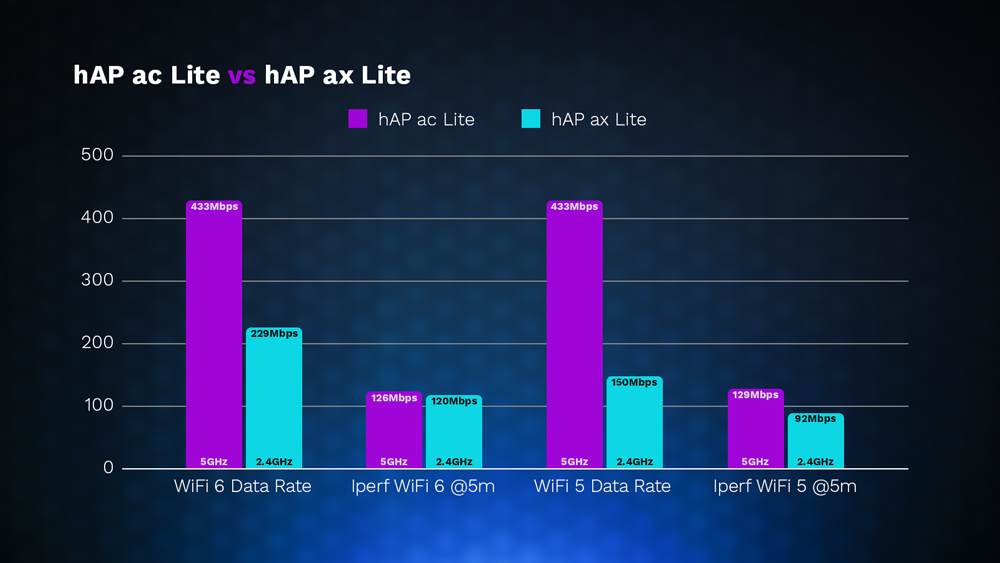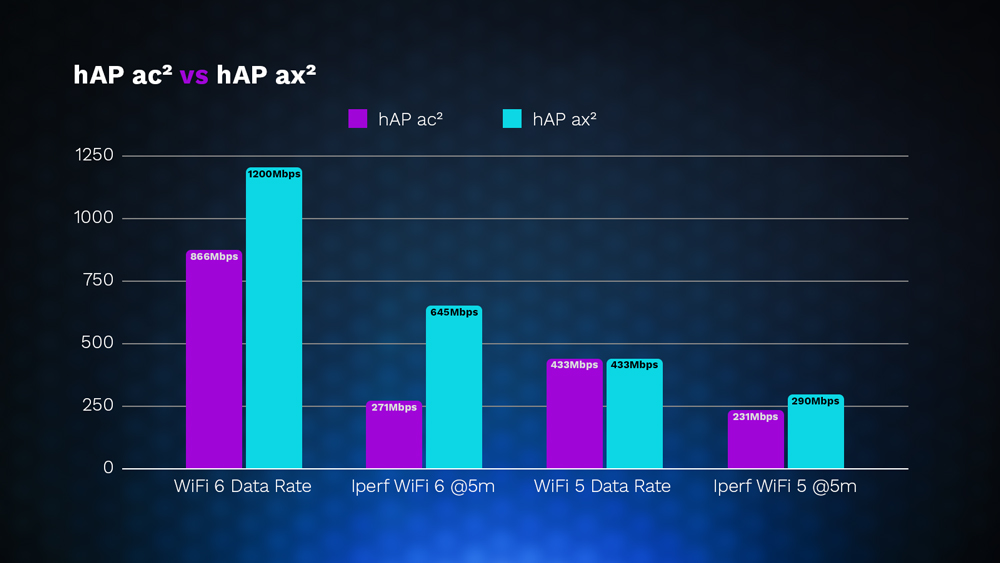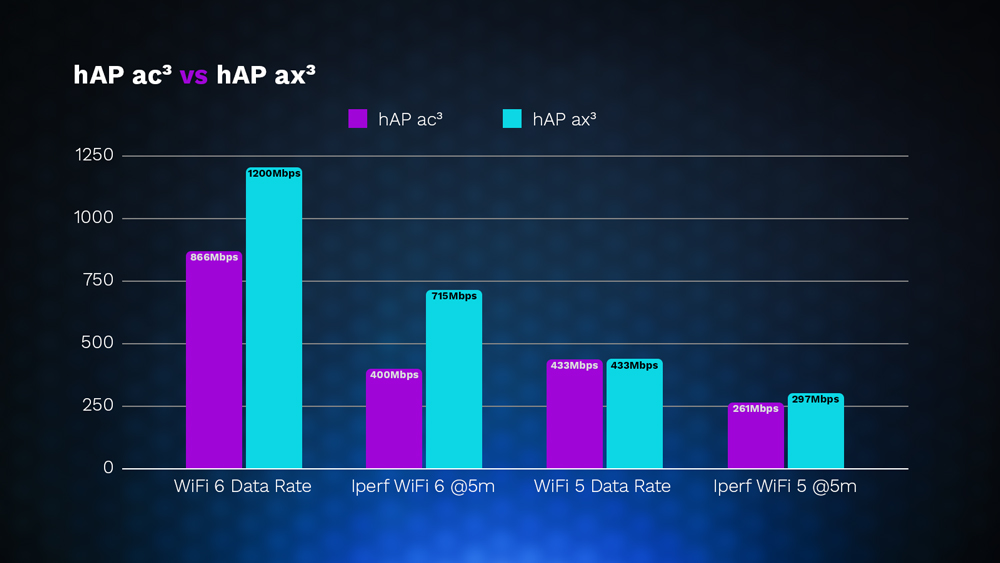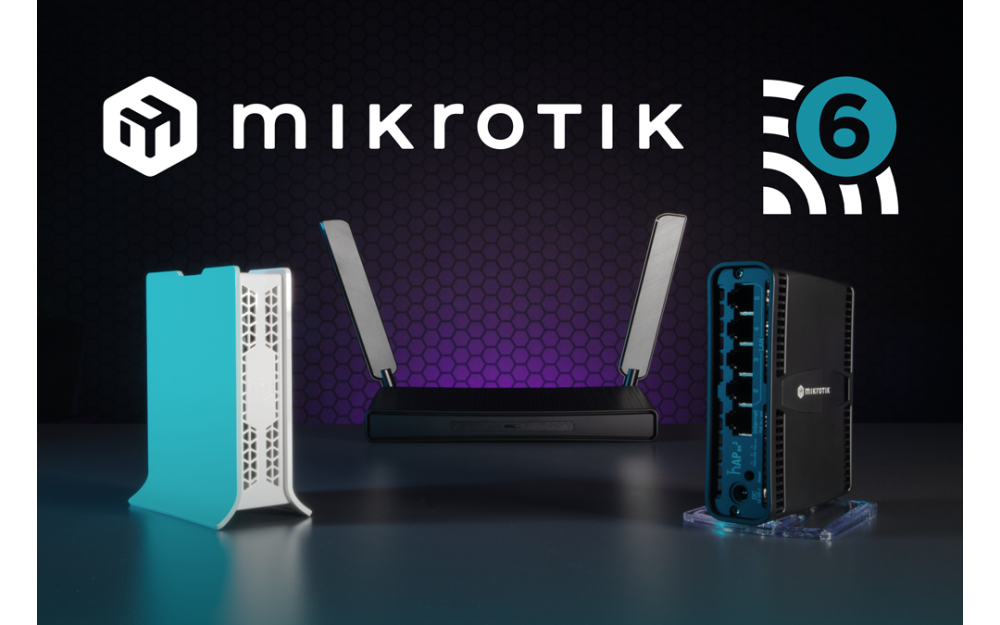MikroTik has released a wide range of WiFi 6 capable home routers that offer performance improvements over their WiFi 5 counterparts at every price point.
The advantages of using the ax standard over its predecessors are well documented. Increased client capacity and faster wireless speeds are the main benefits of the new standard. The client devices should support this protocol, which most modern devices do, to take advantage of all the benefits. It is also backwards compatible with the previous standards, so there is no need to worry about older clients or IoT devices.
We ran our own tests to compare some of MikroTik's hAP range to find out how they fare. Our tests were conducted at close range using the same channel width on the cleanest possible piece of spectrum. We measured the physical rate and ran separate Iperf tests on both WiFi 5 and 6 clients with 10 concurrent data streams for the actual throughput test.
hAP ac Lite versus hAP ax Lite
The hAP ac Lite is a very popular dual-band home router. It offers the advantage of having 5GHz connectivity, but it is limited to Fast Ethernet, so it is only suitable for up to 100Mbps networks.
The hAP ax Lite is MikroTik's entry-level WiFi 6 router with a dual-core processor, increased RAM, and Gigabit LAN. It is around the same price point as the hAP ac Lite but only runs 2.4GHz. This is fine for home use which typically experiences less interference while offering better penetration by using the 2.4GHz band. In our experience, 2.4GHz on WiFi 4 typically never exceeds 100Mbps, so we were interested to see how WiFi 6 could improve on this.
Our expectations were not high, and naturally, we expected the 5GHz device to provide a much higher data rate. However, looking at the actual throughput, the performance between the two is very similar at around 125Mbps to our WiFi 6 client. Home users would benefit from better coverage under a single SSID when using the hAP ax Lite and be able to use Gigabit devices on Ethernet. There is no question that a dual-band device has its benefits, but it is interesting to see that 2.4GHz on WiFi 6 could keep up with 5GHz on the hAP ac Lite.
Note that MikroTik has also released the hAP ax Lite LTE6, an LTE-capable version of the WiFi 6 device.

hAP ac2 versus hAP ax2
The hAP ac2 is a 5-port, dual-band router with Gigabit interfaces. It is a step up for users looking to leverage a powerful quad-core RouterOS device in a compact case.
The hAP ax2 is the WiFi 6 upgrade to the hAP ac2 and also features POE in and out, with more powerful hardware and higher gain antennas in an awesome-looking compact chassis. This one has WiFi 6 on both 2.4GHz and 5GHz, so we expected it to put up some fight against its predecessor.
In this test, we figured it would be more interesting to see how they compare on 5GHz as we already know the capabilities on 2.4GHz. We ran the same tests as before and were very impressed with the outcome.
The hAP ax2 beats the hAP ac2 hands down, with the WiFi 6 client showing significant improvement in throughput and far exceeding our expectations. There was no real difference when using the WiFi 5 clients. If you are looking for an upgrade without a huge price jump, the hAP ax2 is an obvious choice.

hAP ac3 versus hAP ax3
The hAP ac3 is a so-called "prosumer" Gigabit router with a quad-core CPU, 256MB RAM, and high-gain external dual-band antennas. The larger antennas are the stand-out feature since the rest of the hAP range will provide limited coverage to bigger households.
Besides using the latest WiFi standard, the hAP ax3 also has one 2.5Gbps port alongside its Gigabit interfaces and, just like its cousin, has two external high-gain antennas. Based on our previous tests, our expectations were at their highest, with no contest from the AC variant.
As you can see, it far outperforms its competitor across all tests and provides the best performance throughout the range. It is a significant upgrade to its predecessor for anyone looking for a "higher-end" router for home or office use but does come with a bit of a price jump.

WiFi 6 client devices are everywhere these days, and it makes sense to upgrade in situations where an extra performance boost is required. Besides just the obvious throughput improvements at close range, the 6th Gen standard can maintain higher data rates at longer distances. The High Efficiency channels coupled with improved MU-MIMO performance handle more concurrent client connections, which have become common even in the standard home.
MikroTik is a fantastic option as they have devices suitable for all scenarios and provide maximum configurability to cater for all types of network environments.








